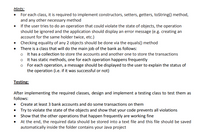
Database System Concepts
7th Edition
ISBN: 9780078022159
Author: Abraham Silberschatz Professor, Henry F. Korth, S. Sudarshan
Publisher: McGraw-Hill Education
expand_more
expand_more
format_list_bulleted
Question
I need it on netbeans please

Transcribed Image Text:Hints:
For each class, it is required to implement constructors, setters, getters, toString() method,
and any other necessary method
• If the user tries to do an operation that could violate the state of objects, the operation
should be ignored and the application should display an error message (e.g. creating an
account for the same holder twice, etc.)
Checking equality of any 2 objects should be done via the equals() method
• There is a class that will do the main job of the bank as follows:
o It has a collection to store the accounts and another one to store the transactions
o It has static methods, one for each operation happens frequently
o For each operation, a message should be displayed to the user to explain the status of
the operation (i.e. if it was successful or not)
Testing:
After implementing the required classes, design and implement a testing class to test them as
follows:
• Create at least 3 bank accounts and do some transactions on them
• Try to violate the state of the objects and show that your code prevents all violations
• Show that the other operations that happen frequently are working fine
At the end, the required data should be stored into a text file and this file should be saved
automatically inside the folder contains your Java project

Transcribed Image Text:Overview:
A new bank wants to make a simple application to keep track of all accounts and transactions.
In this TMA, it is required to help the bank manager implement the required application.
Requirements:
After a quick meeting with the bank manager, you got the following information:
• It is required to store all bank accounts in one collection and all the transactions happened
in another collection.
Each account has a unique account number, a holder and balance. There is a specific prefix
(common for all accounts) that should be added to the holder's civil id to create the unique
account number. In addition, it is not allowed for a holder to have more than one account.
Furthermore, only three transactions are allowed on any account: deposit, withdrawal and
transfer money to another account.
Each holder has a unique civil ID (national id), a name and other attributes (add at least 2
attributes from your choice).
• For each transaction, it is required to store the account(s) affected, amount of money, date,
and if they are successful. There are 3 types of transactions: deposit, withdrawal and
transfer.
Moreover, you have been informed that the following operations happen frequently:
• Creating a new account
• Deposit money into a specified account
• Withdrawal money from a specified account
• Transfer money between two specified accounts
• Printing details of the transaction where the maximum amount of money has been
transferred between 2 accounts
• Saving all accounts and transactions into a text file.
For accounts, they should be sorted in ascending order (according to the civil id)
Analysis:
Q1: There are common attributes and methods between the three types of transactions. What
is the best choice for designing and writing their codes? Explain your answer.
Q2: Draw a simple class diagram showing only relationships between the classes.
Implementation:
After analysing the given requirements, implement the required application:
• with Object Oriented Programming style
• following the rules of good programming style (e.g. adding comments, etc.)
using only the material covered in M251 (and its prerequisites)
Expert Solution
This question has been solved!
Explore an expertly crafted, step-by-step solution for a thorough understanding of key concepts.
Step by stepSolved in 2 steps with 6 images

Knowledge Booster
Learn more about
Need a deep-dive on the concept behind this application? Look no further. Learn more about this topic, computer-science and related others by exploring similar questions and additional content below.Similar questions
- Learn all you can about the US Safe Web Act. What is it? Provide some examples of court cases that involved violations of this act. What are some of the punishment(s) if someone is found guilty? Please help to write 2 pagesarrow_forwardReview https://cardinality.readthedocs.io/en/latest/ (Links to an external site.) What is the cardinality that this link refers to? How would you use it? compare this to Sympyarrow_forwardHow do you determine the difference between fake and genuine content on the internet?arrow_forward
arrow_back_ios
arrow_forward_ios
Recommended textbooks for you
 Database System ConceptsComputer ScienceISBN:9780078022159Author:Abraham Silberschatz Professor, Henry F. Korth, S. SudarshanPublisher:McGraw-Hill Education
Database System ConceptsComputer ScienceISBN:9780078022159Author:Abraham Silberschatz Professor, Henry F. Korth, S. SudarshanPublisher:McGraw-Hill Education Starting Out with Python (4th Edition)Computer ScienceISBN:9780134444321Author:Tony GaddisPublisher:PEARSON
Starting Out with Python (4th Edition)Computer ScienceISBN:9780134444321Author:Tony GaddisPublisher:PEARSON Digital Fundamentals (11th Edition)Computer ScienceISBN:9780132737968Author:Thomas L. FloydPublisher:PEARSON
Digital Fundamentals (11th Edition)Computer ScienceISBN:9780132737968Author:Thomas L. FloydPublisher:PEARSON C How to Program (8th Edition)Computer ScienceISBN:9780133976892Author:Paul J. Deitel, Harvey DeitelPublisher:PEARSON
C How to Program (8th Edition)Computer ScienceISBN:9780133976892Author:Paul J. Deitel, Harvey DeitelPublisher:PEARSON Database Systems: Design, Implementation, & Manag...Computer ScienceISBN:9781337627900Author:Carlos Coronel, Steven MorrisPublisher:Cengage Learning
Database Systems: Design, Implementation, & Manag...Computer ScienceISBN:9781337627900Author:Carlos Coronel, Steven MorrisPublisher:Cengage Learning Programmable Logic ControllersComputer ScienceISBN:9780073373843Author:Frank D. PetruzellaPublisher:McGraw-Hill Education
Programmable Logic ControllersComputer ScienceISBN:9780073373843Author:Frank D. PetruzellaPublisher:McGraw-Hill Education

Database System Concepts
Computer Science
ISBN:9780078022159
Author:Abraham Silberschatz Professor, Henry F. Korth, S. Sudarshan
Publisher:McGraw-Hill Education

Starting Out with Python (4th Edition)
Computer Science
ISBN:9780134444321
Author:Tony Gaddis
Publisher:PEARSON

Digital Fundamentals (11th Edition)
Computer Science
ISBN:9780132737968
Author:Thomas L. Floyd
Publisher:PEARSON

C How to Program (8th Edition)
Computer Science
ISBN:9780133976892
Author:Paul J. Deitel, Harvey Deitel
Publisher:PEARSON

Database Systems: Design, Implementation, & Manag...
Computer Science
ISBN:9781337627900
Author:Carlos Coronel, Steven Morris
Publisher:Cengage Learning

Programmable Logic Controllers
Computer Science
ISBN:9780073373843
Author:Frank D. Petruzella
Publisher:McGraw-Hill Education